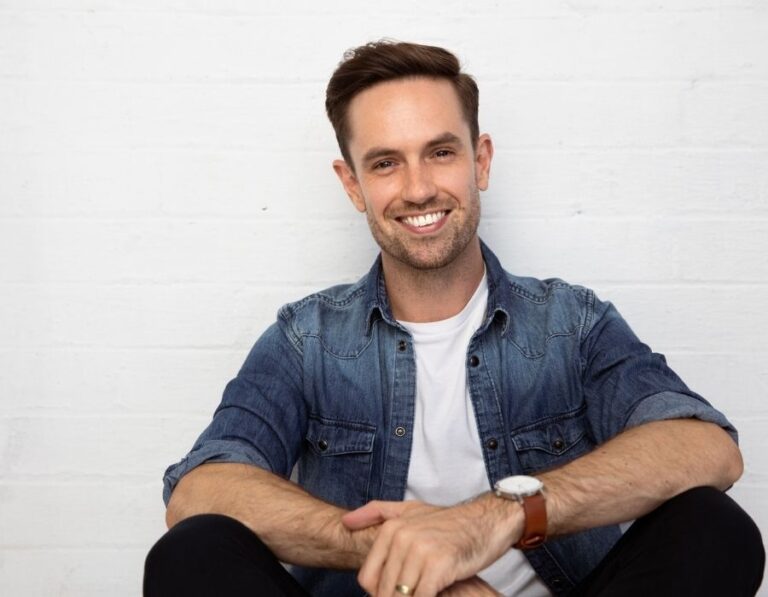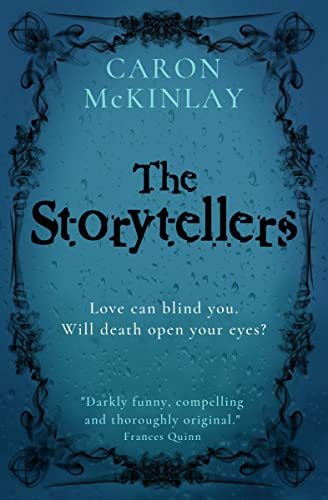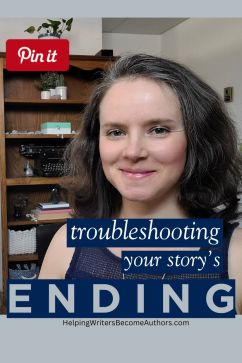 Hello, everyone, today we’re going to be talking about how to troubleshoot your story’s ending. Today’s post (which is a transcript of the video linked below) is in response to a couple of questions I received about endings. One is from Ayesha Ali:
Hello, everyone, today we’re going to be talking about how to troubleshoot your story’s ending. Today’s post (which is a transcript of the video linked below) is in response to a couple of questions I received about endings. One is from Ayesha Ali:
How about some posts about crafting endings. I just reached the end of a manuscript, and I realized that my character arc and themes weren’t strong enough to craft a compelling ending. I wrote as much as I could, and jotted down the last few lines I’ve been holding on to, but filed it away to look at in another few months. So, whether you have a strong enough arc or not, how do you decide which bits go in the climax? How do you structure on a smaller level those beats? How do you avoid the climax being a string of sequel scenes and explanation?
Another question was from Esther Gonzalez Bertran:
I support this topic, I would like to know more about how to outline a good ending, and how to write a beginning that is reflected in the ending, or is it the other way around?
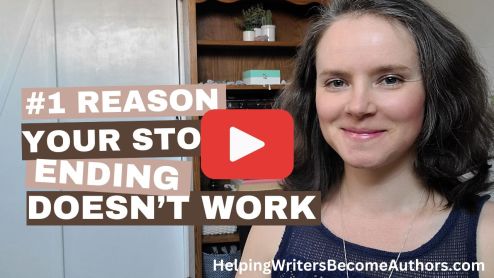
The #1 Reason Your Ending Doesn’t Work
Over the last couple of months in the last few videos, we’ve talked about beginnings, starting with the importance of setting up character and then with the importance of setting up plot. We touched on how setting up the beginning is always something you’re thinking about as you’re building into the ending. If you know the ending, that can help you set up the beginning. And vice versa, if you’ve done a really good job in the beginning, you can bring that full circle by the time you get to your story’s finale.
The most important thing to understand about troubleshooting your story’s ending is that if the ending doesn’t work, the ending probably is not the problem. The problem is probably that things weren’t set up in the right way throughout the book. The problem could be just that the Third Act isn’t working, but it could also be a problem that goes all the way back to the First Act and to the beginning.

Structuring Your Novel (Amazon affiliate link)
You have to take a bird’s eye view of how your story is coming together structurally and how that’s building into the ending you want to create. It is important to hold this idea in your head that the ending is in the beginning. Whatever you write in the beginning—even if it’s very far away from wherever your characters get to in the ending, and even in some instances, if you don’t know yet what’s going to happen in the ending—whatever you’ve set up in the beginning, whatever seeds you’ve planted, even down to the imagery sometimes, that setup will create the cohesion and the resonance that needs to come full circle in your story’s ending.
If your ending isn’t working, it’s either because it wasn’t the ending that was actually set up in the beginning or because the beginning and/or subsequent parts of your story failed to set up the ending by the time you get there. Again, the problem with endings usually isn’t something that’s happening in isolation
The Climactic Moment Defines Your Story’s Ending
It’s important to understand what is the function of the ending.
What are you trying to build toward throughout your story’s entire structure? The point of the ending simply is that in the Climactic Moment, your protagonist definitively ends their relationship to the plot goal.

Creating Character Arcs (Amazon affiliate link)
Very often, this is because they definitively gain the plot goal (i.e., whatever they’ve been seeking throughout the entire story). It could also be that the antagonist definitively gains the plot goal, keeping the protagonist from having it. In other stories, it can be perhaps that the protagonist has the plot goal within their reach, but they choose to let it go because of their character arc and how they’ve evolved over the course of the story, they realize this is no longer in alignment with who they are and who they’ve become. So they choose to let it go. Regardless, they are no longer in pursuit of the plot goal that they have been moving toward throughout the story.
As a result, there is no longer any reason for there to be obstacles between them in that plot goal. That’s what creates the conflict. Once you have no conflict, you no longer have a plot. No plot, no story. The story is at an end.
The purpose and the focus of your story’s ending is the Climactic Moment and how it definitively determines whether or not your protagonist will get the plot goal they’ve been chasing throughout the entire story.
Analyze Your Story’s Structure to Troubleshoot Your Ending
Once you know what your Climactic Moment will be, that allows you to look back over your story’s entire structure and particularly the main structural beats.

Click to enlarge.
Pull out the main structural beats and look at them in isolation. We’re talking about things like the Inciting Event and the First Plot Point, the Midpoint (or Second Plot Point), and the Third Plot Point. and making sure they all have thematic unity. They should all be about the same thing. They’re all specifically about the character’s relationship to the plot goal that will be decided in the Climactic Moment. Your Climactic Moment is always going to prove what your story is really about.
If all of your structural moments have been about one thing (for example, a relationship plotline), and then the Climactic Moment is about something else (for example, catching a bad guy), that is an instance where the structural throughline is mismatched. You’re really trying to tell two different stories. It’s fine to have one of those stories as a subplot. But the Climactic Moment needs to be focused on the main structural throughline as proven by what’s happening in all the structural beats.
If you feel like your ending isn’t working or it’s mismatched or the conflict has just kind of petered out, the top thing to ask yourself is, “Is the Climactic Moment in alignment with everything that’s come before?”
Analyze Your Story’s Theme to Troubleshoot Your Story’s Ending

Writing Your Story’s Theme (Amazon affiliate link)
You can also determine what your story’s theme is really about by looking at the Climactic Moment. In that moment, what is your protagonist’s relationship to the thematic Truth?
- In a Positive Change Arc, the protagonist will have grown into and embraced that Truth.
- In a Negative Change Arc, the protagonist will have grown away from the Truth.
- In a Flat Arc, they will have maintained their relationship to the Truth, and the characters around them will have evolved into an appreciation and understanding of it.
Identifying which fits your story will also show you what your story is about thematically. Again, you can look at all of the structural beats leading up to the Climactic Moment to make sure the same theme is showing up, that you’re not proving one theme through the character’s actions in earlier structural beats and then highlighting something completely different by the time you get to the Climactic Moment. You want to achieve cohesion, resonance, and thematic unity throughout your entire story.
How to Tell if Your Story’s Ending Is Strong Enough
The answer to the question about whether or not your ending is strong enough really depends on the particular story. How much of a punch your Climactic Moment packs really does depend on just the nature of the story and how dramatic it has been. The level of impact in your Climactic Moment will correspond to how definitively the character gets the goal.
In some stories, the protagonist’s ending relationship to the goal is actually pretty ambiguous. Particularly in series, what may be a definitive enough relationship to that goal at the end of Book One is then going to evolve in the conflict in future books. And in other stories, it’s purposefully ambiguous because it’s trying to prove a thematic point. In most stories, the more definitively your character ends their relationship with the plot goal, whether they get it or not, will determine how strong that ending feels to readers.
You can also consider how strong your character’s arc is. That will be largely determined by the tension that exists between the story’s Lie and Truth. Some stories have a very dramatic arc where the tension is strong between the Lie and Truth, because they are complete opposites.
For example, the character might arc from hate to love. That’s a huge arc. In other stories, the arc is much subtler, for example moving from indifference to love or apathy to love. That’s a little baby arc. And that’s fine, depending on the type of story. Not all stories want something extremely dramatic. It depends on what’s best for your story. What do you want to have happen? What do you want to accomplish? If you knowing that, you can judge that by the time you get to the end whether or not you are able to accomplish that.
Can the Climax Be a Sequel Scene?
Ayesha asked: “How do you avoid the Climax being a string of sequel scenes and explanation?”
The Climax should never be totally comprised of sequels, reactions, or explanations. In scene structure, the sequel is the reaction part of the scene structure. The Climax is about a final deciding action, to reaction. It is the “sceniest” scene in your entire story.
In classic scene structure, we can split scenes into two halves, which we call scene and sequel, which are action and reaction. The action half is made up of goal, conflict, and outcome. And that literally describes the Climax, right? It is the job of the Resolution, the scenes that follow the Climax, to show character reactions and finish any explanations or loose ends that need to be shared.
If you feel like all that’s happening in your Climax is explanations and reactions, then either you’re misidentifying what is really your Climactic Moment (i.e., when the character definitively gets or loses the plot goal), or you’ve skipped it. In the latter instance, the Climactic Moment doesn’t exist and you’ve just kind of petered out with your story. In this case, you can go back and identify your character’s plot goal and how it can be resolved in the end. Then make sure you have a strong scene that demonstrates this to readers. The Climax, above all, is not the place to tell versus show.
Strengthen Your Ending by Having It Mirror Your Beginning
Here’s one final thing to think about as you’re troubleshooting your ending and figuring out where the previous parts of the story might have gone wrong so they’re not leading up to your ending in the way you want. Think about the idea of chiastic structure.
Chiastic structure is where the two halves of the story mirror each other. The beats in the first half mirror the beats in the second half in some way. Story structure is just naturally this way, in that the beats in the first half will set up the plot, whereas the beats in the second half will pay it off. You can take this a little further and do it a little more consciously and specifically when it comes to your ending, and we talked about this a little bit in some of the previous posts about beginnings.
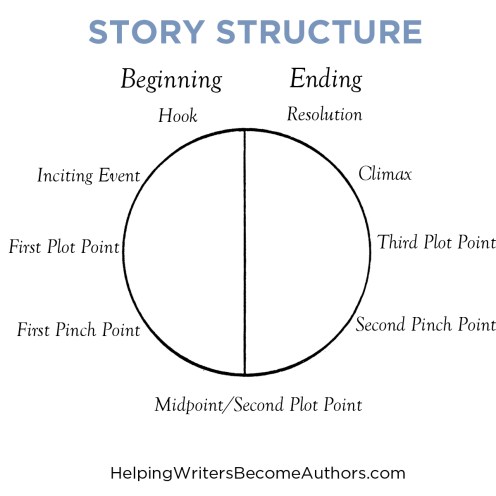
Look at how the Hook in the very beginning of your story and the Resolution in the very ending mirror each other. For instance, you have a Characteristic Moment in the beginning in the Hook; you can mirror that with another Characteristic Moment in the ending in the Resolution.
More to the point of what we’re talking about today, you also want to look to the Inciting Event which happens around halfway through the First Act. This is the Call to Adventure that kicks off the character’s pursuit of the plot goal. How does that mirror what happens in the Climactic Moment? How does that set it up? You can think of the Inciting Event as a question that has to be answered by the time you get to the Climactic Moment.
***
Endings are actually quite simple. Everything funnels down to one single point in the Climactic Moment. It’s actually quite a simple thing. But everything that’s come before to lead up to this is very complex.
In even the simplest novel, you’ve got chapters upon chapters and characters and themes, all these loose ends you’re weaving that have to come together and funnel down into this one single point. Everything that’s come before must make sense and be thematically related to this one point.
It’s a lot to think about and consider. We always say it’s one thing to hook readers with a good beginning and it’s another thing to hook them with a good ending—because then they will want to keep reading. It’s not just about getting them to finish this one book. It’s about convincing them you can give them a satisfying story experience so they’ll want to read on into the next book you may be writing, whether it’s in a series or not.
Endings are, as we all know, extremely important. They prove whether or not a story works. There are many stories people enjoy throughout until they get to the ending and upsets them in some way—because it doesn’t make sense or it doesn’t work or they feel like the writer didn’t play fair with them.
It’s important to understand the technical definition of what you’re trying to accomplish with a story’s ending. You need to understand how it functions structurally and therefore how it’s a part of the structure that leads up to it, in the plot, the character arc, and the theme. This allows you to bring all of these things together in a solid Climactic Moment that ends your story’s conflict.
Wordplayers, tell me your opinions! What are some of your top questions when troubleshooting your story’s ending? Tell me in the comments!
Click the “Play” button to Listen to Audio Version (or subscribe to the Helping Writers Become Authors podcast in Apple Podcast, Amazon Music, or Spotify).
___
Love Helping Writers Become Authors? You can now become a patron. (Huge thanks to those of you who are already part of my Patreon family!)


